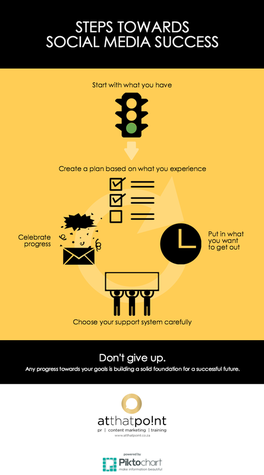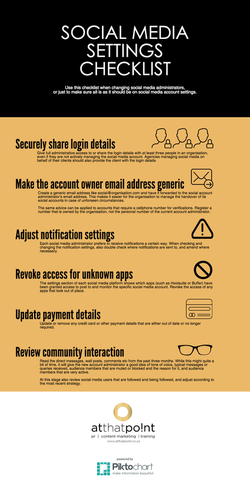 Authored by; Rosa-Mari Le Roux, Content Manager at At that Point They say, “If it wasn’t for the last minute, nothing would get done.” However, with an effective communication and marketing strategy in place, nothing would be left until the last minute. Your strategy should serve as a road map for your business to effectively communicate a tailored message via the right channels to reach your desired audience. My article will feature important elements to keep in mind when creating a marketing and communication strategy for your business. Bull’s eye What is the point of doing business if you don’t have a clear idea of who your customers are and what they want? Consumer insights are crucial for creating a targeted message and this valuable information can be gathered through surveys, questionnaires or interviews. Get to know your audience’s characteristics and familiarise yourself with what they read, listen to and watch. This will help you formulate your communication plan and customise your products so that it caters specifically to their desires, which should lead to better sales and happy customers. Don’t beat around the bush It is crucial to define your message, ensure that it is clear, consistent and recognisable. Keep these key points in mind when formulating your message: - Brand Identity: Your customers should be familiar with your brand identity, which must be noticeable in all marketing material and platforms. Your reader should always know it is your message. - Consistency is key: All communication and messaging should be consistent. Your company message should be communicated throughout every department within the business. - King of creativity: Be creative and unique with your ideas and messages. This will set you apart from the rest. Choose the right channels The easiest way to reach your existing audience, is to use channels where your consumers are already active, such as social media. The message that you intend to communicate should be the driving force to determine which channels you use. For instance, using video content on social media platforms rather than emails. Fortunately, there are many platforms that you can use to get in contact with your potential customer. If you know your audience, as suggested earlier, you will have a better idea on which channels you will have the most success in reaching customers. Importantly, whatever marketing channel you choose should have the same brand perception as yours. Remember “consistency is key” Keep your enemies close Lastly, know who your competitors are and what they are up to. They are probably keeping an eye on you too. The harder it is for other to duplicate what sets you apart, the better. Keep your competitors in mind when creating your strategy. This will always keep you one step ahead. To communicate without a strategy, is like walking in total darkness. You never know what might be lurking around the corner. Your strategy is your road map, your source of light, if you will.
0 Comments
 Authored by: Stephné du Toit, Content Manager, At That Point Do your marketing meetings usually include a discussion around how you should be doing more video on your social media platforms? Then a month goes by and you still haven’t managed to get a single video done? Like they say, procrastination is the thief of all things. This is usually because the process of making a video seems like a daunting task to the average person. However, it does not have to be a difficult or expensive exercise, you can therefor stop hesitating and get started. The easiest way to do this is to start at the beginning and methodically work your way through the production process. Here are some simple steps to get you going, and before you know it, it will become second nature. Planning Get your team around the table, and if you do not have a team, get some of your creative employees to form part of your brainstorming session. Ask yourselves, what do we want to achieve? What are the actions we want to stem from this video? Who do we want to reach with our message? Here you must set a definitive aim, if you shoot too broadly, you are going to miss your target. Now you can start writing, plan your setting and create a storyboard to plot the scenes or message points of you video. Type of video Depending on your message, you have to decide if you will be using an articulate person to convey the message, or if you would just like to use text to elevate your main points of your message. Either way, there are a lot of free stock image and video sites on the internet where you can source great visuals to support your message Also make sure your speaker is prepped, relaxed and as natural as possible. Remember, the whole video does not have to be done in one shot. Keep your segments short, this will make it easy to cut and edit. 1…2…3 Action! Plan your video set well in advance. Make sure to focus on the small things – those that can make or break your video, such as:
Round off with some editing No, you do not have to be a professional to edit your video. There are a lot of free and easy movie editing software online. Make sure to cut the unwanted content, use transitions to switch between scenes and add a bit of background music to create your desired mood. Do not forget to add your company logo and have a call to action at the end, even if you are just inviting your audience to visit your website for more information. Go live! The most important thing to remember when you create and post social media video, is to keep it sweet and short. Your aim is not to make a blockbuster movie, but rather to give a targeted message to a specific audience regarding your services, product or business. You therefor best keep to a one- to two-minute video, at the most. Then upload your video to your website or YouTube channel that you created for your business. From there, you can link back to your video by posting a short description and link onto your various social media platforms. Remember practice makes perfect! If you just start and keep going you will soon wonder how you ever communicated to your audience without video. Administrators on social media accounts often change due to employees moving on, changes in outsourced service providers, or the appointment of a dedicated inhouse resource. Sometimes the handover of the social media account administration rights is a smooth process with lots of help, but other times it is surrounded by hostility for a variety of reasons. Whatever the circumstances of the administrator change, it's always a good idea to check a few settings before getting started with posting content and community engagement. If I missed anything, please let me know in the comments section!
 Getting started with promoting your business on social media is similar to starting on the journey to a healthy lifestyle. You might be tempted to follow any number of quick-start plans and silver bullets that promise great results with little to no work. The only way to meaningful change is however through continued focused work and accepting that results might be slower than you hoped. The good news for those willing to let go of comfortable habits is that once you get started, you’ll find that it’s really not that hard to stick to your resolutions. Start with what you have One of the most common mistakes when getting started is to focus too much on research and treatments and quick fixes, and not enough time doing the work needed. Waiting for a special date to start – like New Year or a product launch – and placing your trust in special tools only delays the inevitable. Starting with what you have and know, and learning as you progress is a much better idea. Create a plan based on what you experience It is not enough to just “do something” if you want to achieve long term results. While doing something is better than doing nothing, a comprehensive longer term plan will keep your efforts on track. Start with a simple plan that specifies what you want to achieve, the tools and help you have available, and how often you can spend time on it. Keep in mind that regular, smaller activities have been shown to be more successful and easier to keep up. Put in what you want to get out To form new habits you need to take the change seriously. In the beginning you will need to think about it all the time so that nothing to distracts you from your goals. As new habits replace old ones it will become easier to add more challenging goals to your plan. Progress is completely up to you; what you put in will reflect in what you get out. Choose your support system carefully It will be a lot easier to achieve your goals if the people that surround you are positive and encouraging. Build a support system that allows you to ask questions and get experienced answers or sensible dialogue. If you decide to get someone dedicated to help you, make sure that the person really wants to help, and is not just doing it because it’s their job. Celebrate progress It’s easy to do something new when your enthusiasm is still high but old habits usually threaten to take over. When this happens, don’t give up. The process of change might be slow in the beginning, but it gets easier and quicker as you continue. Together with your overall goal, set smaller short term goals, and celebrate those goals once you’ve achieved them. These small celebrations will for a long way in motivating you and those around to keep up the good work. Don’t let go of your vision just because of a few (or a lot) of apparent failures. Remember that any progress towards your goals is building a solid foundation for a successful future. |
Archives
November 2020
Categories
All
|
||||||


 RSS Feed
RSS Feed